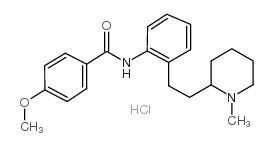Demonstration of proarrhythmic activity with the class IC antiarrhythmic agent encainide in a canine model of previous myocardial infarction.
A A Wallace, R F Stupienski, T Kothstein, J R Gehret, J J Lynch
Index: J. Cardiovasc. Pharmacol. 21(3) , 397-404, (1993)
Full Text: HTML
Abstract
The antiarrhythmic efficacy and proarrhythmic potential of the class IC antiarrhythmic agent encainide were assessed in subacute and chronic postinfarction canine models, respectively. In conscious dogs with spontaneous premature ventricular complexes (PVCs) at 48 h after anterior myocardial infarction (MI), cumulative intravenous (i.v.) administration of 1.0 and 3 mg/kg encainide significantly reduced PVC frequency. However, in anesthetized dogs studied more chronically after anterior MI (range 8-44 days), i.v. administration of 0.3-3 mg/kg encainide resulted in induction of new ventricular tachyarrhythmias by programmed ventricular stimulation in 6 of 10 dogs with no inducible arrhythmias prior to encainide. Newly induced arrhythmias after encainide administration included unimorphic and polymorphic ventricular tachycardia (VT) as well as VT degenerating rapidly into ventricular fibrillation (VF). The incidences of new arrhythmia induction after cumulative i.v. administration of encainide were 3 of 9 after 0.3 mg/kg i.v. encainide, 4 of 9 after 1.0 mg/kg i.v. encainide, and 5 of 10 after 3.0 mg/kg i.v. encainide. Time elapsed between MI and electrophysiologic testing tended to predict proarrhythmic response to encainide, with the six preparations with newly induced arrhythmias tested earlier than the four preparations that remained nonresponsive to postencainide programmed stimulation (13.2 +/- 3.1 vs. 26.5 +/- 6.5 days postinfarction, respectively, p = 0.07). There was also a trend toward larger underlying anterior MIs in the six preparations with newly induced arrhythmias as compared with the four preparations that remained nonresponsive to postencainide programmed stimulation (13.2 +/- 2.9 vs. 7.5 +/- 2.1% of left ventricle, respectively, p = 0.19).(ABSTRACT TRUNCATED AT 250 WORDS)
Related Compounds
| Structure | Name/CAS No. | Molecular Formula | Articles |
|---|---|---|---|
 |
Encainide hydrochloride
CAS:66794-74-9 |
C22H29ClN2O2 |
|
Encainide hydrochloride and flecainide acetate: two class 1c...
1987-11-01 [Clin. Pharm. 6(11) , 839-50, (1987)] |
|
ST segment elevation induced by class IC antiarrhythmic agen...
1998-11-01 [J. Cardiovasc. Electrophysiol. 9(11) , 1167-72, (1998)] |
|
Adherence and arrhythmic mortality in the cardiac arrhythmia...
1996-03-01 [Ann. Epidemiol. 6(2) , 93-101, (1996)] |
|
Developmental electrophysiology of encainide and its major m...
1994-01-01 [Biol. Neonate 66(6) , 330-8, (1994)] |
|
Antifibrillary action of class I-IV antiarrhythmic agents in...
1995-07-01 [J. Cardiovasc. Pharmacol. 26(1) , 132-6, (1995)] |